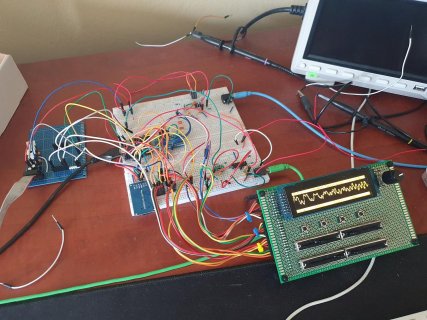waxxmaster
New member
Hi !
I wonder if this is possible to get a 12 bit precision with Teensy 4.0, when using SPI devices at the same time?
I explain :
I'm developing a synthesizer (eurorack wavetable module) around the Teensy 4.0 and i need to get hi-precision ADC read for CV (control voltage) inputs (and for sliders/pots).
I manage to get this precision (without noise at all) using ADC + DMA reads, and averaging the 128 values of the DMA buffer for each inputs. (i'm doing a sort of round robin reading on two ADCs).
But, as soon as i send data to a SPI DAC (TI DAC8565) + a screen (SSD1322 256x64), i get lot of noise in ADC reads, i can't manage to obtain minus than 5 values of noise (on 12 bits readings, 4096 values).
Is there a way to reduce SPI device noise in ADC reads ?
My prototype is on a breadboard
i've tried to :
- separate the 3.3v power for analog and digital, but i didn't get any improvement.
- the teensy is powered by external 5v (not USB)
- add decoupling capacitors almost everywhere, but same problem
sorry if that is a naive question, i'm not very well experienced in electronics.
Thank you if anyone has any clue.

I wonder if this is possible to get a 12 bit precision with Teensy 4.0, when using SPI devices at the same time?
I explain :
I'm developing a synthesizer (eurorack wavetable module) around the Teensy 4.0 and i need to get hi-precision ADC read for CV (control voltage) inputs (and for sliders/pots).
I manage to get this precision (without noise at all) using ADC + DMA reads, and averaging the 128 values of the DMA buffer for each inputs. (i'm doing a sort of round robin reading on two ADCs).
But, as soon as i send data to a SPI DAC (TI DAC8565) + a screen (SSD1322 256x64), i get lot of noise in ADC reads, i can't manage to obtain minus than 5 values of noise (on 12 bits readings, 4096 values).
Is there a way to reduce SPI device noise in ADC reads ?
My prototype is on a breadboard
i've tried to :
- separate the 3.3v power for analog and digital, but i didn't get any improvement.
- the teensy is powered by external 5v (not USB)
- add decoupling capacitors almost everywhere, but same problem
sorry if that is a naive question, i'm not very well experienced in electronics.
Thank you if anyone has any clue.


